All about the orchid flower stalk
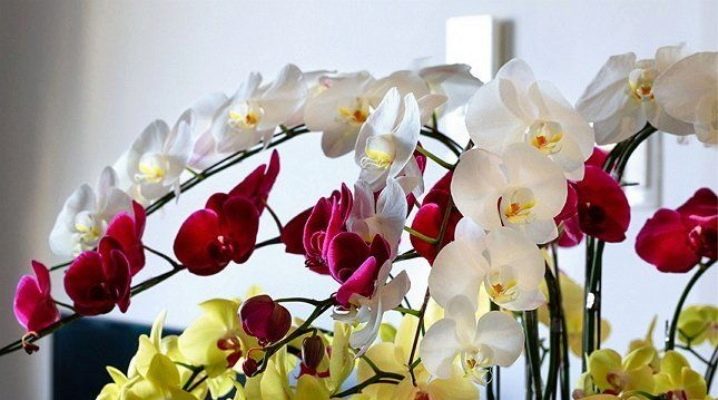
A flower stalk is a special shoot of an orchid, on which buds appear, after which they transform into beautiful flowers. It is important to be able to identify the peduncle at first glance in order to provide it with proper care and conditions afterwards.
Peculiarities
The peduncle looks like a rather long and flexible stem, reminiscent of a bird's beak. As soon as its length reaches a certain value, buds will begin to appear. During growth, the stem can bend in different directions, and then strive exclusively upward. Some even curl up into a ring. It is important to distinguish the peduncle from other parts of the bush, since sometimes it must be cut off immediately. This happens in cases where the orchid has recently suffered a disease or has just been planted. In this case, they need additional strength to grow.
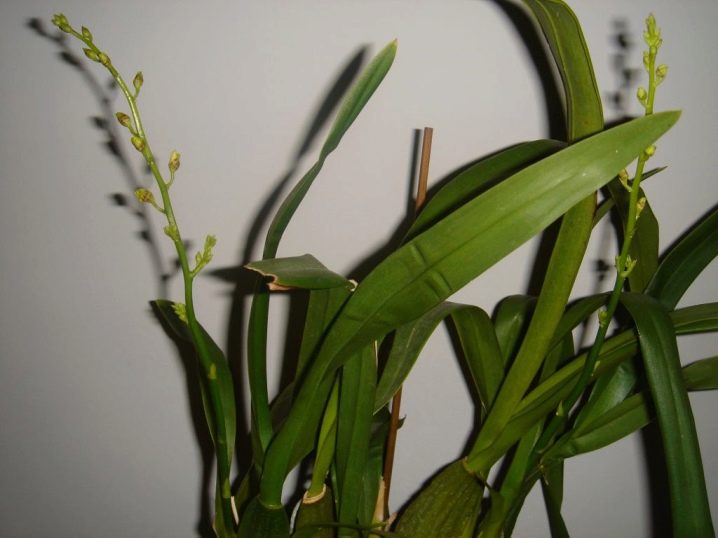
The peduncle of a plant can be either just appeared or already old. The young stem is colored light green or bright green. It grows either upward or slightly diagonally, striving towards the sun. The flat peduncle has a sharp tip and few scales. After the end of flowering, its shade changes from green to yellow-brown.
Some species can have red or even deep purple hues. As soon as the last flower withers, it is better not to wait for the stem to dry, but to cut it to the base yourself. Such a solution will help not to waste the power of the plant. However, some gardeners choose not to remove the old stems, relying on the fact that they will either bloom again or give birth to babies. At what stage of the cycle the peduncle is located can be determined by the state of its tip: a green bud can still bloom, but an already yellowed, blackened or dried bud cannot be restored.
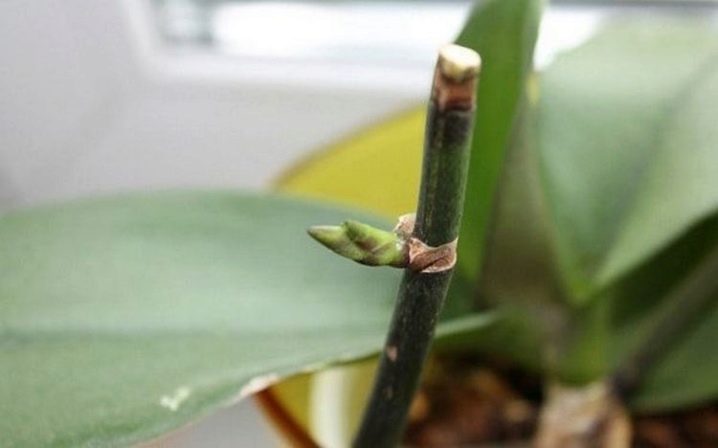
When and where does it appear?
The orchid releases a young thin peduncle from the bosom - the place where the leaf meets the stem as much as possible. Over time, a small arrow transforms into a full-fledged long and flexible stem, on which buds are already appearing. This, in turn, leads to the fact that the peduncle begins to sink. It is important to distinguish the peduncle from the root, which grows under the leaves at the base of the bush, but sometimes passes between the leaves. In addition, the tip of the shoot is pointed, and at the root it is rounded and blunt. The surface of the peduncle is often covered with scales, which cannot be said about the root system.
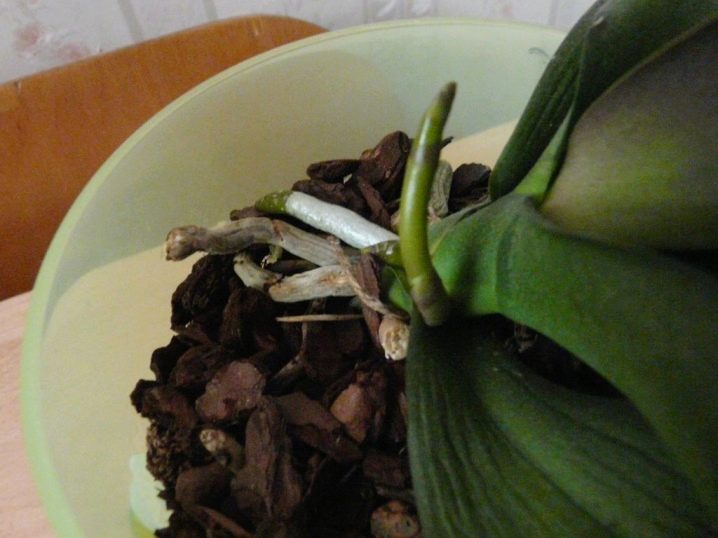
Autumn is considered the most successful season for the appearance of stems, but leaves appear in the summer months. The period from the beginning of the formation of the peduncle to the immediate flowering does not last too long - about eight weeks. Depending on the lighting system, this gap can change up or down. By the way, if at the same time the orchid releases both a peduncle and a new leaf, then you should not cut off either one or the other - the plant itself will determine what it will develop further.
It is worth being prepared that sometimes, if the temperature regime is not observed, children form on the orchid instead of flowers. It is also caused by damage to the root system, the result of which is the cessation of the supply of nutrients.
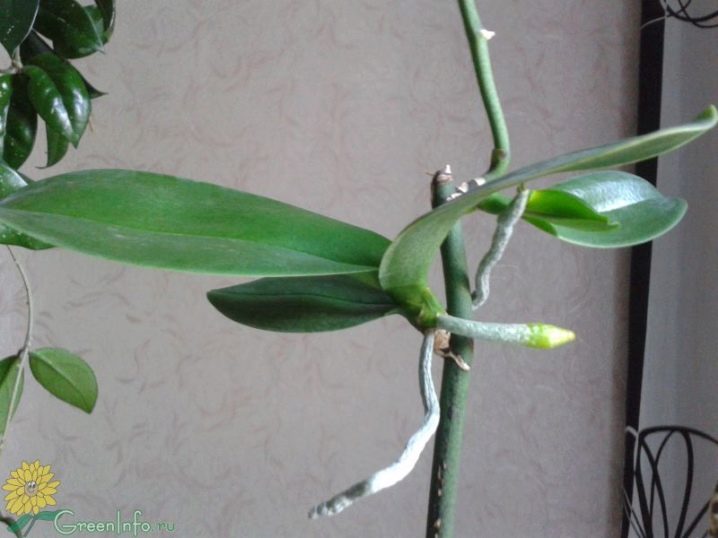
How to stimulate his education?
If the orchid does not let flower stalks for a long time at the required time of the year, it is necessary to do several procedures to stimulate their appearance. First, it is important to ensure that the flower is at a comfortable temperature. Secondly, it would be a good idea to artificially create stressful conditions for him for a while. For example, significantly reduce the amount of water used for irrigation, or stop irrigation altogether after flowering begins. Alternatively, you can also create a short-term temperature difference.
Even several stress factors can be combined: lower the temperature to 18 degrees, reduce daylight hours by a couple of hours, and stop irrigation for more than a week. As a result, returning to its usual habitat, the orchid will begin to bloom.
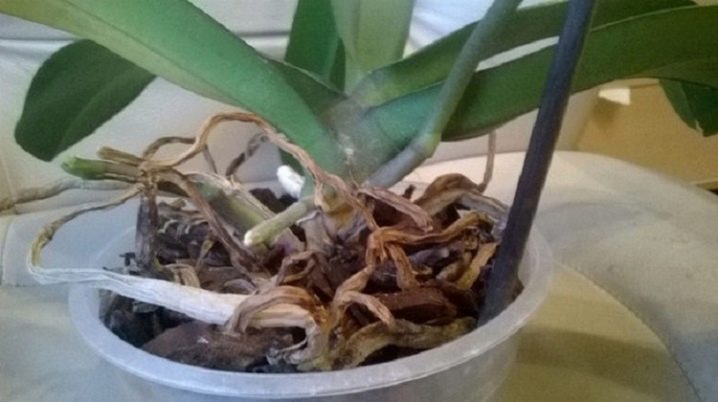
Care during growth
When the orchid has released a peduncle, it will have to be looked after in a different way. It is important to maintain a fairly high humidity, which reaches 60% to 70%. In addition, regular feeding is required. If possible, cultivation should take place in transparent containers: this will provide an additional light source. Adequate illumination, in general, is important at this time, therefore, in the cold and gloomy season, it is better to install additional light sources, such as phytolamps.
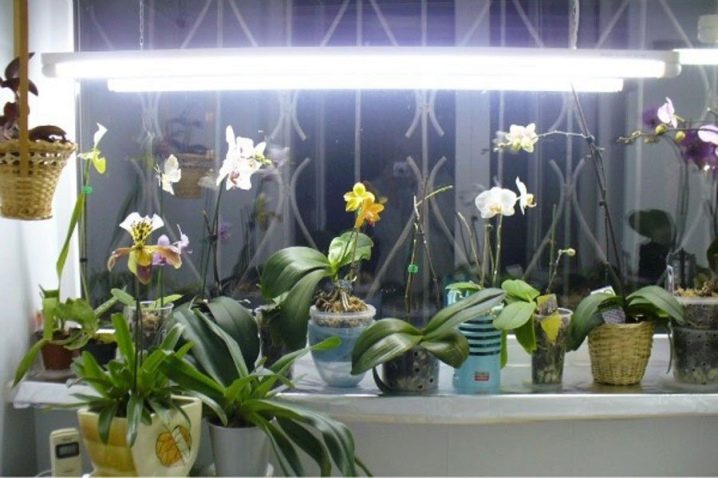
The same applies to the flowers located at the northern windows.
During the growing period of the peduncle, you should not move the pot or even turn it.
The temperature should correspond to the temperature in the tropics, the difference between day and night degrees is also important. The optimum temperature during the day is from 20 to 24 degrees, and at night - from 15 to 18 degrees. The orchid will definitely have to be protected from both drafts and warm air currents.
Transplanting the flower is not recommended. It is necessary to water it in the first half of the day with a warmed-up liquid. As soon as the first flowers appear, the frequency of irrigation will have to be reduced. The peduncle must be fixed with special props, otherwise it can break corny with a large number of flowers. Fertilization should stop as soon as the first buds are formed. The bottom line is that their number will not increase even with regular feeding, but an excess of fertilizer can negatively affect the development of the orchid.
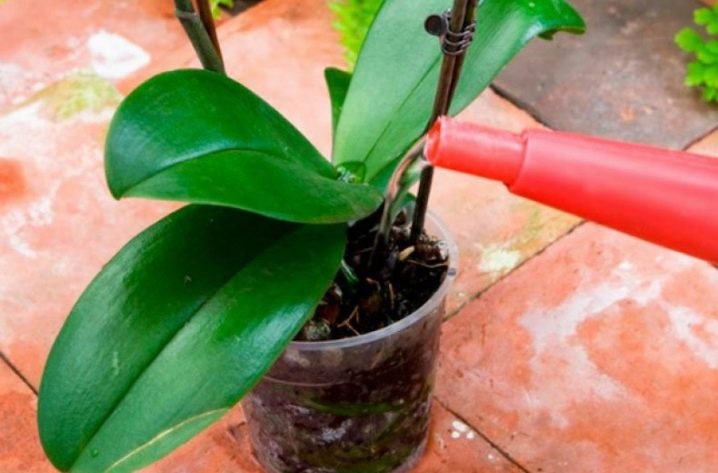
How to grow an orchid from a peduncle?
In order to transform the peduncle into a full-fledged orchid at home, it is necessary to use the lateral processes of the peduncle, which already have roots, that is, children. If you provide proper care, they will take root in a new place extremely quickly. Faded stems are also used for reproduction. Using a hormonal paste containing cytokinin in the composition, you can independently grow a baby, which is then transplanted. Having chosen a healthy and strong flower, it is necessary to carefully cut off dried scales from a dormant bud or from a stem node.
Followed by a necessarily disinfected needle, a depression of a small diameter is created, where a little paste is applied. After some time, spent by the orchid in conditions of sufficient light and with the introduction of nitrogen-containing dressings, new children will appear.
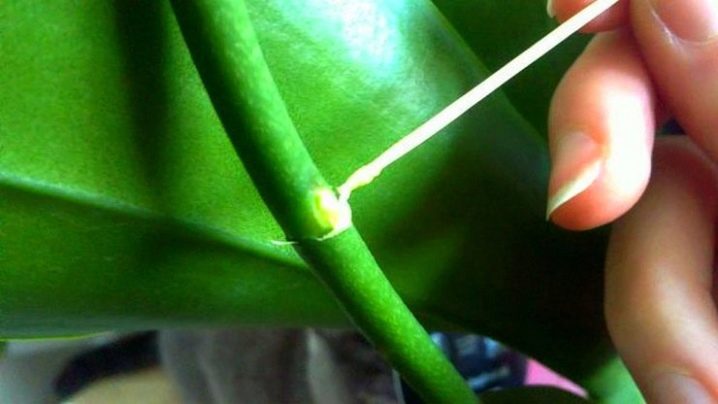
Possible problems
The orchid itself is not a particularly persistent flower, therefore it is important to look after its peduncle correctly in order to prevent unpleasant situations from arising. However, some of them cannot be corrected at all, and such moments have to be treated with understanding. For example, if an arrow appears in the wrong place, then nothing can be done about it. All that remains is to wait and observe the development of the plant. In principle, even such a wrong flower can produce flowers or a baby.
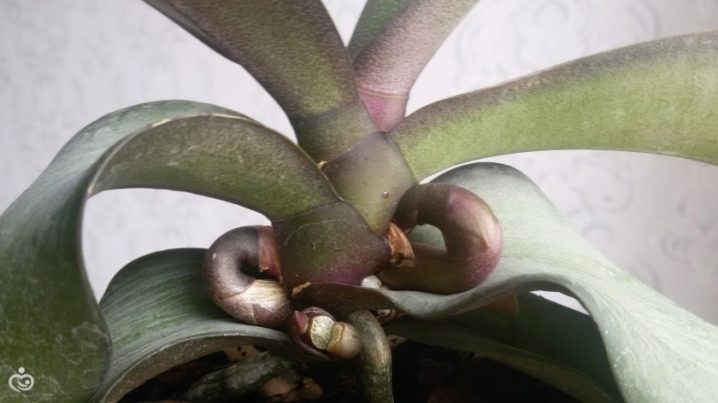
If the peduncle broke, for example, during a move or careless action, it will need to be cut off.
The place of the cut passes over the highest possible kidney and must be processed after either coal or cinnamon powder. When the stem has broken completely, almost at the base, it is still recommended to cut it off so that at least a minimal shoot remains. In the case when it is impossible to form a stump, the place where the peduncle broke off, it is important to process it again with cinnamon powder or coal. In the event that further the orchid does not dry out below the cut point, the restoration proceeds normally - soon it will be possible to expect a repetition of flowering. If the peduncle dries up, then the gardener will have to wait for the emergence of a new one.

If the peduncle suddenly stopped growing, this is most likely due to improper living conditions. It is necessary to check and normalize the temperature and irrigation regime. As further measures, it is recommended to use fertilizers or growth stimulants.
If sticky drops appeared on the orchid, both on the peduncle and on the leaves, then the cause is either waterlogging, or the action of pests, or a disease. In this case, it is recommended to start by determining the air temperature and, if necessary, lowering it, reducing watering and stopping spraying, as well as separating the flower from other plants. The appearance of sticky droplets is typical for aphids, ticks, mealybugs or scale insects. In this case, immediate treatment is necessary. An orchid affected by a tick must be washed with laundry soap, and in a situation with aphids, the soil must be additionally dried.
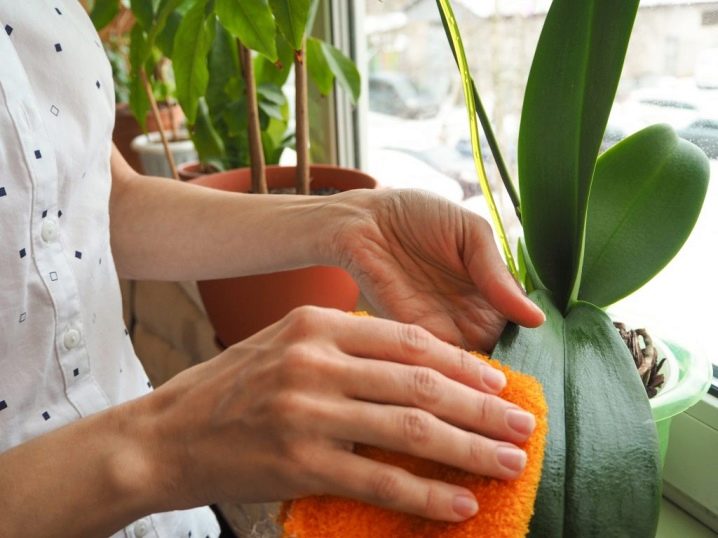
In both cases, the flower is regularly sprayed until it is completely healed. In addition, it is recommended to adjust the temperature regime, since it is the high temperatures that promote the spread of insects. Of the diseases, such symptoms are characteristic of powdery mildew. Treatment begins with lowering the temperature and drying the waterlogged soil mixture. It is also recommended for a while lower the humidity level. Finally, Topsin-M will have to process the orchid.
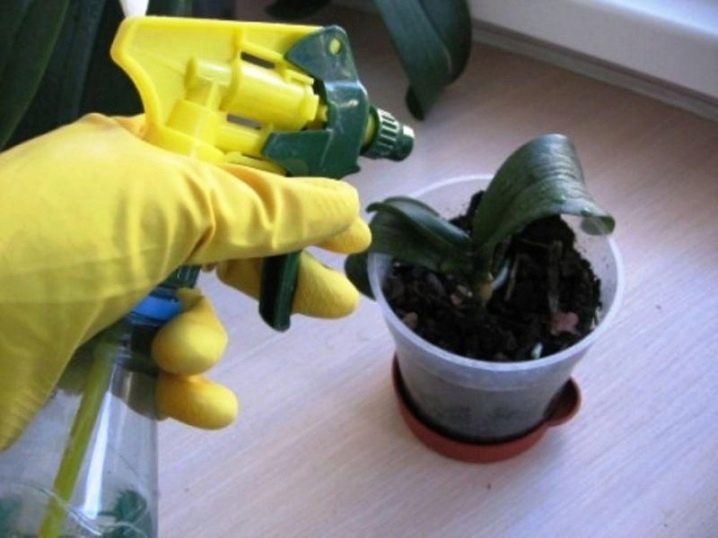
By the way, sometimes sticky drops are a symptom of normal transpiration, a natural process that results from excessive amounts of nutrients.
In such a situation, it is enough just to regularly wipe the peduncle, increase the low temperature, reduce the amount of watering, and also not apply fertilizer.
If the orchid peduncle has turned yellow, then it is recommended to trim it down to living (that is, green) tissue. Further events can develop in two directions: either the yellowing will stop, and a new stem with buds will begin to form on the hemp, or the peduncle will fall off by itself, and a new branch will appear next year
... In any case, there is no sense in worrying about such a situation and taking emergency measures.
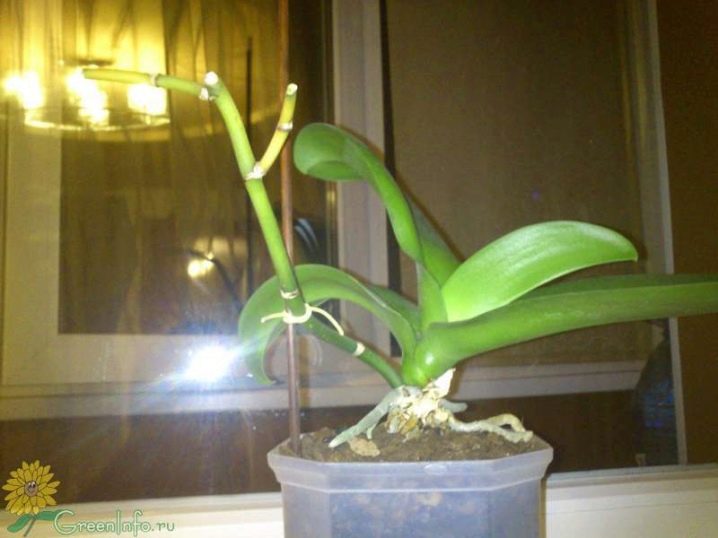
For information on what needs to be done during the period of peduncle growth and budding in orchids, see the next video.































The comment was sent successfully.